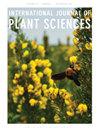美国北达科他州晚古新世褐环虫Manchester & Dilcher的新特征
IF 1.5
3区 生物学
Q3 PLANT SCIENCES
引用次数: 0
摘要
研究的前提。描述了北达科州Almont和Beicegel Creek地区晚古新世褐环蝇(cyclolocarya brownii, Juglandaceae)和具有新解剖结构的翼果的化石后代。这些化石表明,褐环虫与现存环虫有许多相似之处,但在形态和解剖特征上有所不同。环树属化石记录的比较证明了现存最古老的核桃科属在进化过程中的特征转变。方法。用反射光显微镜(LM)对化石进行数字成像。部分标本包埋在沃德生物塑料合成树脂中,切片成晶片,装在载玻片上,用反射LM成像。用醋酸纤维素剥离技术制备Beicegel Creek遗址的过矿化标本,装在载玻片上,用透射LM成像。从新鲜采集的材料中拍摄了现存的枸杞果实。关键的结果。黄菖蒲的后代与现代黄菖蒲的后代在几个方面不同。化石为总状花序,在细长的花梗上结有密集的果实。相比之下,现存的C. paliurus的穗上每个花序的果实较少(10比23)。果实壁的解剖结构与现存和其他已知的环果属化石物种相似,但更为复杂,具有独特的异母细胞层,在现存环果属植物中不存在。化石花粉是三孔的,而现存环孢属的花粉是四孔的。和现存的环花属植物一样,花粉既在雄蕊花絮中传播,也偶尔在附着在果实上的雄蕊中传播。我们记录了一个带有花粉的雄蕊的水果化石。这一特征在古近纪中也有,在现存的环状虫中是零星的。结论。在果序结构、果实大小和对称性、果壁解剖结构和花粉孔数等方面,晚古新世的褐花蜜桐与现存的褐花蜜桐及其相关化石有所不同。古近纪至今的特征演化趋势包括:(1)由螺旋排列、密分布的有花梗的果实转变为沿细长轴单生的无梗果实;(2)由金字塔形转变为圆形的小坚果,(3)有赤道或基部的翅膀附着;(4)花粉孔数从3个转变为4个;(5)现存环果属的果壁简化。本文章由计算机程序翻译,如有差异,请以英文原文为准。
New Features of Cyclocarya brownii Manchester & Dilcher from the Late Paleocene of North Dakota, USA
Premise of research. Fossil infructescences of the late Paleocene Cyclocarya brownii (Juglandaceae) and winged fruits with newly recognized anatomical structure are described from Almont and Beicegel Creek, North Dakota. These fossils demonstrate that C. brownii has many similarities to extant Cyclocarya paliurus but differs in several morphological and anatomical features. Comparisons of the fossil record of Cyclocarya document the transition of characters in the evolution of the oldest extant genus of Juglandaceae. Methodology. Fossils were digitally imaged with reflected light microscopy (LM). Some specimens were embedded in Ward’s Bio-Plastic synthetic resin, sectioned into wafers, mounted on microscope slides, and imaged with reflected LM. Permineralized specimens from the Beicegel Creek site were prepared with the cellulose acetate peel technique, mounted on microscope slides, and imaged with transmitted LM. Extant fruits of C. paliurus were photographed from freshly collected material. Pivotal results. Infructescences of C. brownii differ from those of modern C. paliurus in several ways. The fossils are racemes with crowded fruits borne on elongate pedicels. In contrast, extant C. paliurus has spikes bearing fewer fruits per infructescence (10 vs. 23). Fruit wall anatomy is similar to that of extant and other known fossil species of Cyclocarya but is more complex and has a distinctive idioblast layer not present in extant Cyclocarya. Fossil pollen is triporate in contrast to the tetraporate pollen in extant Cyclocarya. As in extant Cyclocarya, pollen is borne both in staminate catkins and occasionally in stamens attached to fruits. We document a fossil fruit with stamens bearing pollen. This feature, sporadic in extant Cyclocarya, was also present in the Paleogene. Conclusions. Late Paleocene C. brownii differs in comparison with extant C. paliurus and related fossil forms in infructescence architecture, fruit size and symmetry, fruit wall anatomy, and pollen aperture number. Trends in character evolution from the Paleogene to the present day include (1) changes from helically arranged, densely distributed pedicellate fruits to sessile fruits borne singly along a slender axis, (2) transition from pyramidal to round nutlets with (3) equatorial versus basal wing attachment, (4) a change in pollen aperture number from three to four, and (5) simplification of the fruit wall in extant Cyclocarya.
求助全文
通过发布文献求助,成功后即可免费获取论文全文。
去求助
来源期刊
CiteScore
4.50
自引率
4.30%
发文量
65
审稿时长
6-12 weeks
期刊介绍:
The International Journal of Plant Sciences has a distinguished history of publishing research in the plant sciences since 1875. IJPS presents high quality, original, peer-reviewed research from laboratories around the world in all areas of the plant sciences. Topics covered range from genetics and genomics, developmental and cell biology, biochemistry and physiology, to morphology and anatomy, systematics, evolution, paleobotany, plant-microbe interactions, and ecology. IJPS does NOT publish papers on agriculture or crop improvement. In addition to full-length research papers, IJPS publishes review articles, including the open access Coulter Reviews, rapid communications, and perspectives. IJPS welcomes contributions that present evaluations and new perspectives on areas of current interest in plant biology. IJPS publishes nine issues per year and regularly features special issues on topics of particular interest, including new and exciting research originally presented at major botanical conferences.

 求助内容:
求助内容: 应助结果提醒方式:
应助结果提醒方式:


